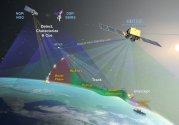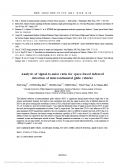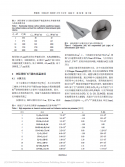Good post, merci beaucoup! No major language errors as far as I could see.Before talking about the differences between HGVs and RVs, let's talk about the similarity between different types of missiles. RVs are missiles "packaged" inside a ballistic missile that is only "ejected" after completing the apogee of its trajectory then "diving" straight towards the target at hypersonic speeds, the HGV is also "packaged" into a ballistic missile , but the difference is that the missile is "ejected" even before completing the heyday of the ballistic missile trajectory, when the reinforcement phase ends, where the HGV dives into the atmosphere and begins to glide at hypersonic speeds, in order to perform leaps to avoid both exoatmospheric and endoatmospheric interceptors. As can be seen, RVs are a type of missile that performs most of its trajectory outside the atmosphere, the HGV in comparison performs jumps in and out of the atmosphere, most of which is made while still in the atmosphere, for this reason is called a "boost-glide" which adopts glide at hypersonic speeds.
In terms of speed, an RV can have higher speeds than an HGV, most certainly do. Most of the time the RV is out of the atmosphere, it gains speeds that are only slowed down when the missile re-enters the atmosphere and starts to suffer atmospheric drag, but even this drag is much smaller than an HGV or HCM, because the RV it just re-enters and dives towards the target, the drag is decreased due to this pre-set trajectory of an RV.
An HGV in comparison trades speeds for altitude/range to evade the defensive systems of the West. Just to clarify the terminal phase of a missile that adopts the boost-glide concept is when it leaves the “glide” phase and stops bouncing in the atmosphere to change speed for altitude/range and dives towards the target until impact. At this stage it does not maneuver as it wants to move towards the target and any corrective maneuver implemented by the guidance system is of small amplitude and likely to be compensated by a sur/air missile, any maneuver in this direction is random step, even to achieve the best target location, some correction needs to be made, from HGV let alone HCM. An advantage of the HGV is that as it only allows defense in the terminal phase (for now and for the next 10 or 15 years) being immune from the intermediate phase (glide) to defend itself, the US would have to have hundreds of defense systems protecting the possible high-value targets. Exoatmospheric intercept systems, on the other hand, are capable of protecting huge areas, even the entire country in the case of the GBI, but tracking is made impossible by the curvature of the earth.
To put the scope into question:
The radar horizon of an object that has reached the apogee of 1200 km is 4500 km(RVs).
The radar horizon of an object in orbit at a height of 150 km is 1600 km away (Chinese Glide-FOBS (G-FOBS)).
The radar horizon of an object 50 km high is 950 km(HGVs).
In all cases, there is enough reaction time for a defense, whether continental, area or point.
Considering all cases as being a speed of 7 km/s, disregarding the parabolic trajectory and variations in speed and aerodynamic drag on reentry.
In the first case there would be a time before impact of 10 minutes.
In the second case it would be almost 4 minutes.
In the third case it would be just over 2 minutes.
The difficulty of intercepting hypersonic threats today, especially HGVs, is not due to their speed but to the altitude at which they fly. The endoatmospheric anti-aircraft and anti-ballistic systems in use today have a vertical range in the range of less than 35 km. HGV-type vehicles fly over 40 km. There is a relatively safe range between 40 and 100 km that is currently not reached by either endoatmospheric or exoatmospheric interceptors. With the exception of THAAD which operates between 40 km and 150 km. The SM-6 and the PAC-3 MSE from 30 km down.
A hypersonic (non-engine) glider does not seem to me to be capable of a trajectory into the atmosphere (even at high altitudes) around the earth due to the loss of speed through friction. Even maneuverability is highly restricted because any wider maneuver at these speeds the loss of kinetic energy is significant.
This current technology of hypersonics offers a greater degree of difficulty because it comes “bouncing” in the atmosphere in order to reach the target by “gliding” and naturally changes its trajectory in a random way, which makes it difficult to intercept in the intermediate phase (glide phase). It will still take at least a decade before there are interceptors that act effectively in this phase (the THAAD is a remote possibility), but in the terminal phase, when it stops gliding and dives towards the target, a hypersonic is not much different from a ballistic reentry vehicle, and in theory just as interceptable as this one, it would give interceptors a kinetic window to shoot down the enemy hypersonic missile. Again, this is in theory. Small maneuvers as well as the altitude at which they plan make interceptor systems very limited, hypersonic missiles are changing a whole concept of missile defense, advances with the THAAD and the PAC-3 MSE are currently in development. The SM-6 some sources indicate it is capable of shooting down a hypersonic missile, but nothing has been confirmed so far by testing.
As I said, some assertions realize that current hypersonic missiles only do the same type of work as previous missiles, but only in a different way, which makes it a promising technology, but not a requirement to have a revolution in the world. military affairs.
It's the same problem 70 years ago and it has never ceased to exist for the simple fact that it is impossible to defend against saturation of ICBMs or SLBMs. If the US launches its ICBMs + SLBMs + cruise missiles with the baits, we're talking about 2000 simultaneous targets – Russia and China have similar capabilities. There is, and never has been, a defense for this. For example (I'm guessing numerically in a hyperbolic way), two hundred of these maneuverable HGVs that cannot be intercepted will do the same job as 2000 traditional ballistic missiles, as several of them will be stopped. And the maintenance costs of 200 HGVs would be much less than 2,000 ICBMs. Some advantage these countries are seeing and are not stuck in a technology of the past decades, a new race is in fact underway around these hypersonic missiles.
ICBMs or SLBMs are ballistic missiles. For example. If you launch one of these from China to the US, you'll have a good idea of where it left off and where it's going to go, just by calculating the trajectory. This makes its interception possible. That's how the entire American ABM apparatus works. Russian and Chinese HGVs, on the other hand, have maneuverability, which makes the calculation for interception impossible. These are totally different concepts.
Forgive me if there is any error in the text, I'm using google translator and it's not a good tool.
You are using an out of date browser. It may not display this or other websites correctly.
You should upgrade or use an alternative browser.
You should upgrade or use an alternative browser.
Chinese Hypersonic Developments (HGVs/HCMs)
- Thread starter A.Man
- Start date
Mars is totally unprofitable, if they waste their resources in that toxic frozen dump all the better. Meanwhile, Luna Base PRC will be generating returns in energy, helium, tourism, vacuum refined metals, scientific services, etc.
Energy is supreme in space. Moon is very energy rich. You can actually run not only solar panels but geothermal gas turbines on the moon (between +100C in exposed surfaces to -100C in a shaded crater). At the poles you have 24/7 insolation in some places. With that amount of power you can run a staggering amount of processes against the thermodynamic energy gradient such as producing oxygen while refining ultra pure metals. Moon has limited water but it has everything else.
Mars is energy poor, everything is fully oxidized already (no chemical energy), planet has dead interior (no geothermal energy) and is far from the sun (poor solar energy). It has almost no potential. Atmosphere is too thin to provide pressure support but thick enough to complicate landings and produce bad weather. You don't need to bring water but you need to bring everything else.
It's OT but I can't resist to add some major points why the moon will be an extremely profitable destination in the near future:
You can build a linear accelerator on the moon's surface like a maglev track and launch mass into anywhere in the earth moon system almost for free (just electricity, no propellant needed except minute amounts for orbital insertion).
The moon has many times the exploitable minerals deposits than earth (no ocean, low gravity means you can dig deep), all the rare earth, rare metals humanity will ever need. Once you mine them all you need to do is compact them into a suitable shape, catapult them towards earth, no need for complex return capsules, just let the atmosphere slow them a bit and smash into some desert...
You can shoot enormous amount of lunar materials into earth orbit, cheapest way to build a 100k tons star destroyer in orbit...
If you are military minded, also note that lunar mass accelerator is a great weapon. Unlimit-ammo orbital kinetic strike on any location on earth.
I don't see it, a standard ICBM with 10 MIRV can easily overwhelm US ABM systems, especially when fielded in large numbers. we dont have enough THAAD, SM3, and GBI to defend the east coast, much less the continental US and definitely not all the nations under the nuclear umbrella. The American viewpoint on hypersonics is to use them purely for conventional strike, as we have immense confidence in our current nuclear deterrent, to the point that removal of the GBD still has some traction. A long range nuclear capable HGV just isnt viewed as necessary in our nuclear policy. There is no race, China and Russia are going one way with nuclear deterrence, the US isn't.You know, some people think hypersonic missiles are just a different shape than other missile systems have done for decades, which I think is complete insanity.
Routinely, when I talk to some other military enthusiasts, they always make this observation about hypersonic missiles, especially when it comes to Russian and Chinese hypersonic missiles that, for some of these enthusiasts, are aiming for nuclear attack, as opposed to the American hypersonic program, aiming quite the conventional scenario, saying that hypersonic missiles are bound to be more accurate than Russian and Chinese, the CPS/LRHW terminal seeker confirms this but will only be implemented in the next Increment program.
The fact is, missiles like Russia's Avangard are making the Americans reshape an entire offensive and defensive apparatus, changing their doctrinal stance that has been in use since the time when the Soviet Union was at its height of military might. The American ABM network is unable to protect the CONUS from missiles like Avangard, the THAAD may have some limited capability against this type of missile, but nothing to conclude that the success rate would be acceptable, and the range would have to be extensively increased to create a credible defense capability. The fact is that even missiles that are in theory less accurate than the Americans are doing are reshaping an entire doctrinal concept that has been in use for many decades.
Moving away from this general perspective of the matter, missiles that are operational like the Avangard and the DF-17, both HGVs, sounded the alert for the Pentagon, although the Americans have been testing hypersonic technology for a long time, probably longer than the Russians and Chinese, Americans lagged behind when it comes to hypersonic missiles, several statements by the US Military High Command report they are in a state of disappointment because the DoD does not yet have any hypersonic missiles operational in the armed forces, while China and Russia are already operational , that from a military point of view, suggests that there are some strategic advantages.
As for the issue of global reach FOBS or HGV, if it is really confirmed, it would be just one more proof that Americans are behind the Chinese in this race. I honestly don't believe in very long range HGV, I would expect the Chinese to implement it in ever-increasing range scale until reaching the point where range would no longer be a priority, the leap in range of the DF-17 (2,500 km ) for a global range HGV (+15,000 km) from my point of view would be unattainable in the short/medium term. The most realistic concept in my opinion would be FOBS + HGV, with HGV being released near Mexico, still far enough away to avoid tracking by ABM radars, it would be a more workable concept, again, from my point of view.
I seriously doubt a sputnik moment could even occur today due to the absolute lack of care most americans have for international relations, Post WWII we were on an extreme internationalist bent, always looking towards what the soviets were doing and hyper focusing on it, currently the domestic situation is one which has been poisoned by populism, instead of a sputnik moment, expect a "I think the whole FOBS angle was mostly spin to be frank, and not in the usual way you might expect.
By putting FOBS front and centre of their coverage, that has automatically become the primary focus of most MSM commentators and general public. The goal is to downplay the significance of the test since FOBS is 30 year old Cold War tech (that China itself tested decades ago).
Because the average American will be alarmed but not really all that concerned that China achieved global strike capability with 30 year old Cold War tech. But they will be a hell of a lot more concerned and worried if you told them instead that China had a hypersonic missile that can circumnavigate the globe and hit any place on earth. Especially as it will be concrete proof that the US is falling significantly behind in critical next gen tech.
You need to remember that the overwhelming majority of the American public still think of China as backwards and genetically handicapped at innovation and advancement and can only progress by stealing and copying from the white man.
To have a ‘Sputnik moment’ where China is shown to be unequivocally more advanced is going to be a massive psychological blow to most ordinary Americans, far bigger than what was actually experienced with even Sputnik. The Russians may be commies, but they were still white.
This needs to be avoided because the American public is going to demand answers as to how this could happen, and with the western MSM having effectively painted the establishment into a corner with their thinly veiled racism against China and Chinese people, the only acceptable answer is that the people in charge in the west have been sleeping at the wheel to allow the clearly genetically inferior Chineseto get ahead.
This is why almost all western MSM coverage on the test has been so muddled and self contradictory. Not because the entirely western MSM couldn’t find a single subject matter expert to give an understandable explanation, but rather because the western MSM has been given the impossible task of hyping up the China-threat agenda while also downplaying Chinese technological superiority.
Why are you wasting money on weapons and not welfare" moment.
I don't see it, a standard ICBM with 10 MIRV can easily overwhelm US ABM systems, especially when fielded in large numbers. we dont have enough THAAD, SM3, and GBI to defend the east coast, much less the continental US and definitely not all the nations under the nuclear umbrella. The American viewpoint on hypersonics is to use them purely for conventional strike, as we have immense confidence in our current nuclear deterrent, to the point that removal of the GBD still has some traction. A long range nuclear capable HGV just isnt viewed as necessary in our nuclear policy. There is no race, China and Russia are going one way with nuclear deterrence, the US isn't.
I agree with you, so much so that I stated that the US will implement hypersonic missiles to hit sensitive targets, as they are embedded within a doctrine in the conventional military context, targeting targets such as anti-aircraft systems, mobile surface-to-surface missile launchers... among other targets.
There is no race, China and Russia are going one way with nuclear deterrence, the US isn't.
Why are you assuming that China's hypersonic requirement is based in nuclear deterrence?
Conventional hypersonic attacks on nodes supporting extended US forces in the Pacific are much more likely.
Chinese military HGV programs include nuclear delivery and conventional strike weapons. It is not an or junction.
In case people have missed it, China test flew and landed a reusable HGV craft intended for commercial or space program use. This isn't nuclear delivery.
In case people have missed it, China test flew and landed a reusable HGV craft intended for commercial or space program use. This isn't nuclear delivery.
escobar
Brigadier
The Americans will already implement the set of Blackjack satellites for infrared detection of hypersonic missiles, the sources claim that the system when operating at its full normal capacity will be able to track an HGV. It is worth noting that the detection of the HGV is already tracked when it is launched, the Soviet FOBS had one of its reasons for canceling the set of satellites capable of tracking the Soviet FOBS still being launched, making a surprise attack on CONUS impossible. With an HGV, this supposed deficiency still exists, but at the current stage, the only possibility of interception is in the terminal phase with the THAAD, in the reinforcement and in the intermediate phase, an HGV is not yet capable of being intercepted, with the set. Blackjack satellites, there is a remote possibility of intercepting even in the intermediate phase, because the tracking and assignment would be feasible, what remains to be analyzed is the capacity of the interceptor missile.
escobar
Brigadier
The Americans will already implement the set of Blackjack satellites for infrared detection of hypersonic missiles, the sources claim that the system when operating at its full normal capacity will be able to track an HGV. It is worth noting that the detection of the HGV is already tracked when it is launched, the Soviet FOBS had one of its reasons for canceling the set of satellites capable of tracking the Soviet FOBS still being launched, making a surprise attack on CONUS impossible. With an HGV, this supposed deficiency still exists, but at the current stage, the only possibility of interception is in the terminal phase with the THAAD, in the reinforcement and in the intermediate phase, an HGV is not yet capable of being intercepted, with the set. Blackjack satellites, there is a remote possibility of intercepting even in the intermediate phase, because the tracking and assignment would be feasible, what remains to be analyzed is the capacity of the interceptor missile.




